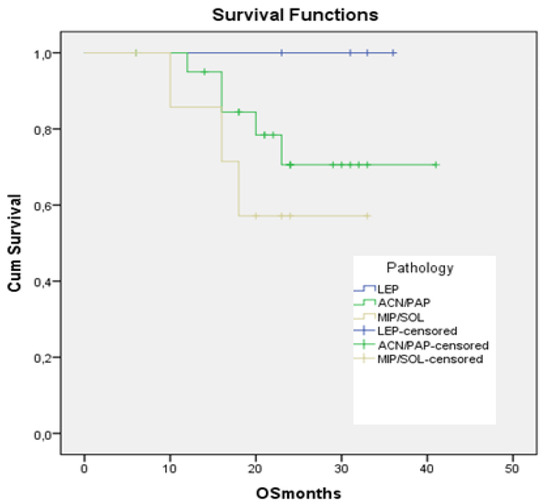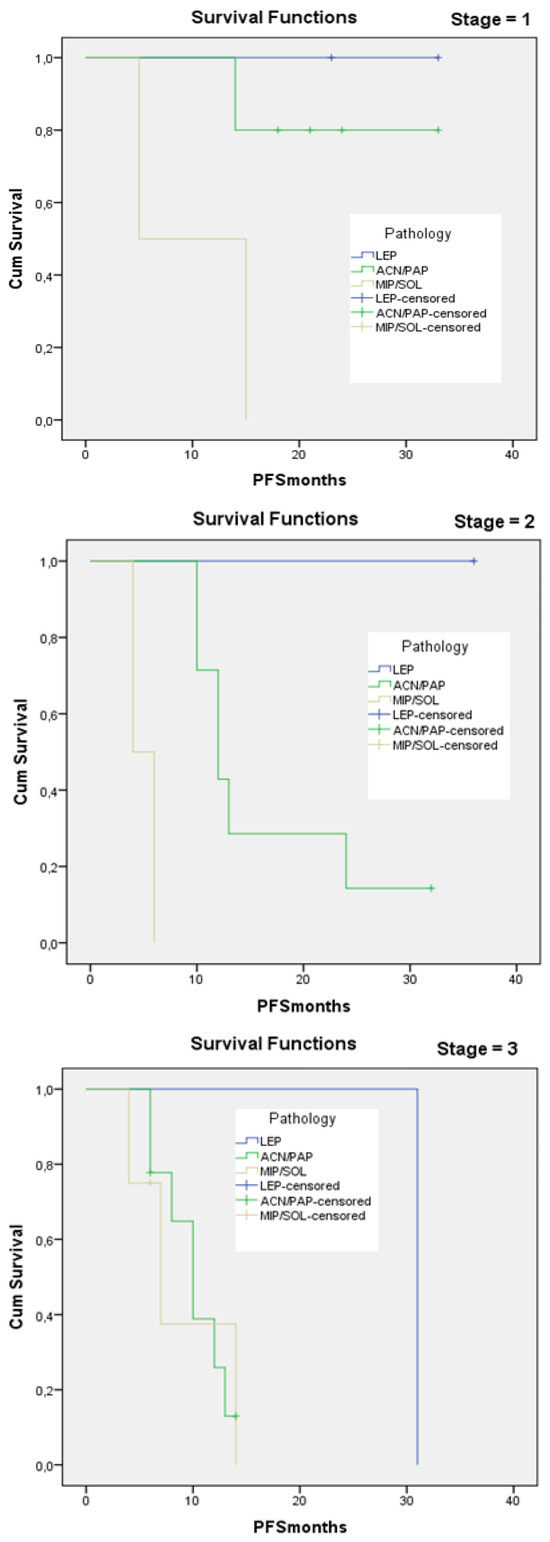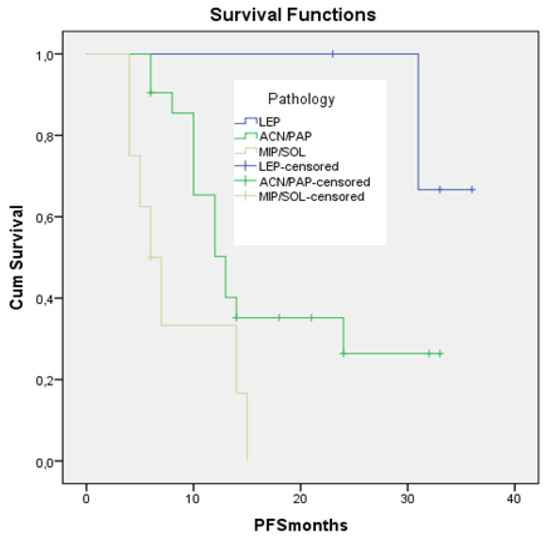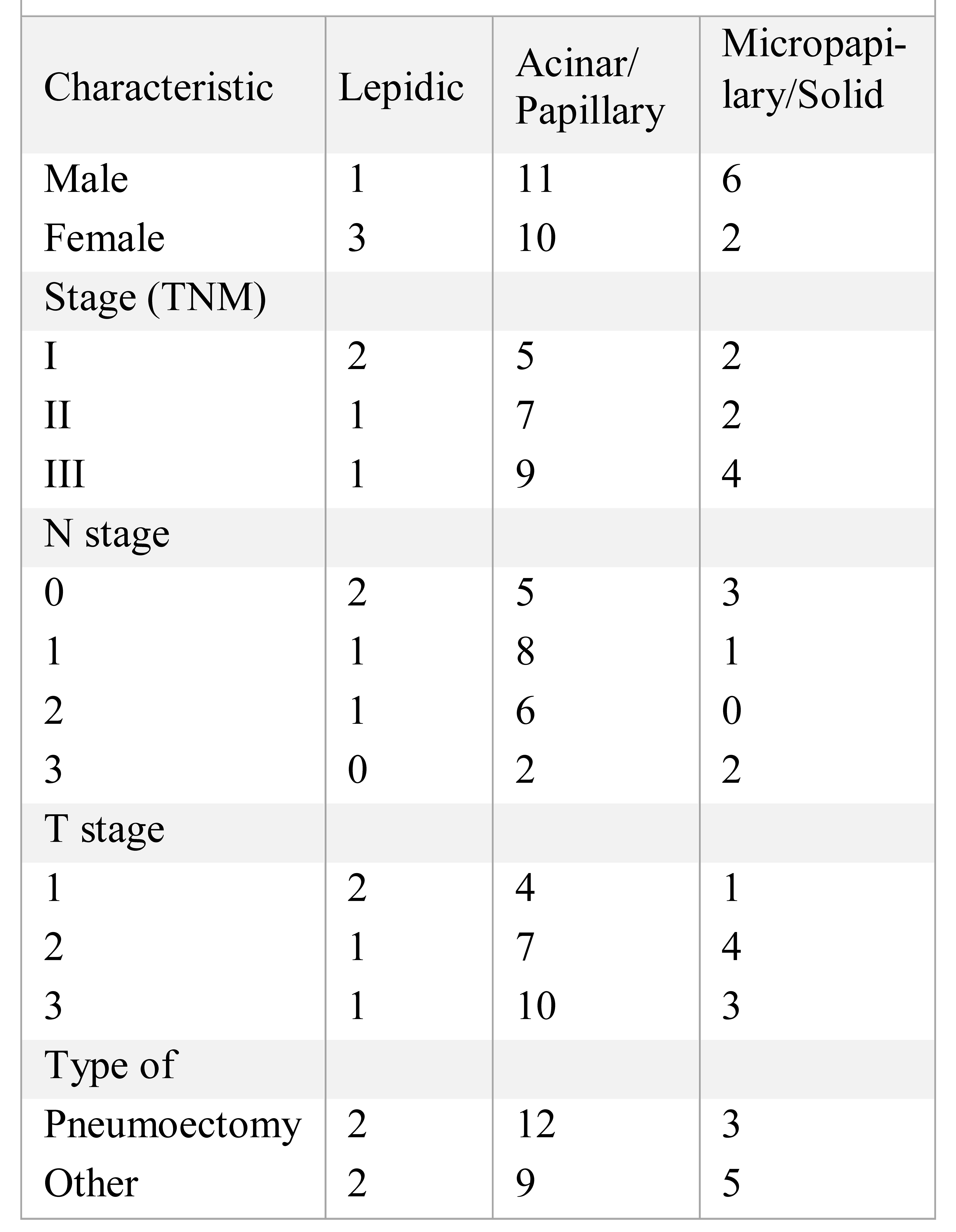Highlights
- The standardization of pathological assessment in lung ADC is essential for both early and advanced stages.
- The lepidic subtype of ADC carries the best prognosis for PFS and OS, whereas micropapillary and solid subtypes are considered the most aggressive.
Highlights
- The standardization of pathological assessment in lung ADC is essential for both early and advanced stages.
- The lepidic subtype of ADC carries the best prognosis for PFS and OS, whereas micropapillary and solid subtypes are considered the most aggressive.
Abstract
Introduction. The latest histological classification of lung adenocarcinoma includes lepidic, acinar, papillary, micropapillary, and solid as subtypes. Testing these subtypes for their prognostic and predictive value is an ongoing scientific challenge. The present research article aims to describe the influence this classification has on patient survival. Materials and Methods. Thirty-three patients were included in the trial. The most important enrollment criterion was the clear specification of the adenocarcinoma subtype in the pathology report. Patients were stratified into three groups which included the adenocarcinoma pathological subtypes as follows: lepidic (LEP), acinar and papillary (ACN/PAP), and micropapillary/solid (MIP/SOL). The primary endpoint was progression-free survival. Other endpoints included overall survival. Results. The lepidic subtype of ADC had superior PFS and OS, regardless of stage. Papillary and acinar subtype showed an intermediate prognosis, whereas micropapillary and solid subtypes were the most aggressive. Conclusions. The experience of this single center confirmed data in the literature. Further studies are needed to demonstrate all the possible implications of this pathology classification.
Introduction
Lung cancer is currently the most frequent neoplastic disease. Even if measures to reduce smoking in the population have succeeded in lowering the rate of lung squamous carcinoma, the incidence of lung adenocarcinoma (ADC) is rising [1]. As opposed to breast and prostate cancer, where pathological subtypes and tumour grading influence both prognosis and treatment decisions, ADC of the lung had no standardized pathological classification until recently, so cancers were frequently reported as mixed histologies. For many years, it was considered that lung ADC was histologically too heterogeneous to permit classifying. Most of the samples have components of all types, with one being predominant. Bronchioloalveolar carcinoma is the exception to this paradigm, being well known to be a pure lepidic tumour.
In 2011, as the International Association for the Study of Lung Cancer (IASLC) and the American Thoracic Society (ATS) issued a novel classification of lung ADC, a search for prognostic significance began. ADC was then classified as lepidic (LEP), acinar (ACN), papillary (PAP), micropapillary (MIP), and solid (SOL). These subtypes are the foundation of the new WHO classification system of lung ADC based mainly on tumour architecture [2]. Some histological subtypes of lung ADC (stage I) benefit more from adjuvant treatment, as recent publications have demonstrated [3]. The prognostic implications in more advanced stages have yet to be demonstrated. The present trial is meant to illustrate the experience of a single institution on this matter.
Materials and Methods
Thirty-three patients were enrolled in this prospective, observational trial. The patients were treated in only one center, Elias University Emergency Hospital, Clinic of Oncology, Bucharest. Enrollment began in 2015 and inclusion criteria included: diagnosis of lung adenocarcinoma, stages I-III, and treated with surgery/ chemotherapy/ radiochemotherapy in any combination. The most important enrollment criterion was the clear specification of the adenocarcinoma subtype in the pathology report. No ’mixed’ histologies were included, even if they specified one predominance. Patients were stratified into three groups which included the following pathological subtypes of adenocarcinoma: lepidic (LEP), acinar and papillary (ACN/PAP), and micropapillary/solid (MIP/SOL). These associations were made because some of them included too few patients for clinical significance. All patients were followed from diagnosis until death for any cause. If death did not occur by the end of follow-up, the patients were censored.
The primary endpoint was progression-free survival, with a secondary endpoint of overall survival. Follow-up was represented graphically using the Kaplan Meier curve. Statistical analysis was processed using SPSS Statistics version 20.
Results
Of the total number of patients (n=33), 27,3% (n=9) were stage I, 30,3% (n=10) stage II, and 42,2% (n=14) stage III. Nodal involvement was distributed as follows: N1- 30,3%, N2- 27.3%, and N3- 12.1%. Mean age at diagnosis was 59.8 years with a maximum of 78 and a minimum of 73, standard deviation 9,78.
51.5% (n=16) of patients underwent pneumectomy and 48.5% (n=16) less extensive surgery. The frequency of the pathological subtypes were: LEP-12.1% (n=4), ACN/PAP -63.6% (n=21), MIP/SOL- 24.2% (n=8). 84.8% (n=28) were assigned to some type of adjuvant treatment (Table 1).

Table 1.
Clinical and demographic characteristics of patients.
The rate of recurrence for stage I and II was 45% during the 41 months of follow-up.
Progression-free survival (PFS) in the three adenocarcinoma subtype groups is represented in Figure 2. Mean time to progression in the LEP group was 34.3 months, whereas in the ACN/PAP and MIP/SOL subgroups, the mean time was 17.6 months and 8.3 months respectively. Log Rank (Mantel-Cox) test value was 11.5, p=.003.

Figure 2.
Kaplan Meier curve for overall survival for the LEP, ACN/PAP and MIP/SOL subtypes.
Overall survival for the same three subgroups is represented in Figure 2. Mean survival time in the LEP group was 29 months, 29 months in the ACN/PAP group, and 17.5 months in the MIP/SOL group. Log Rank (Mantel-Cox) test value was 2.51, p=.285.
PFS was then stratified for each stage for the three subtypes. The results are represented in Figure 3.

Figure 3.
Kaplan Meier curve for PFS for the LEP, ACN/PAP and MIP/SOL subtypes stratified by stage.
Discussions
In the present trial, most patients were stage II, and the most frequent nodal involvement was N2. The most frequent pathological subtypes were ACN/PAP, which is consistent with recent literature data [4]. The LEP subgroup had clear PFS advantage, followed by ACN/PAP subgroup. The reason this trial was designed with PFS as the primary endpoint instead of OS is the relatively short time of follow up (maximum 41 months). Therefore, the present data can be considered a preliminary analysis, as patients will continue to be followed. One of the weak points of this analysis is the small number of enrolled patients and the small proportion of patients with lepidic ADC (only 4). Because of these small subgroups, some analyses, for example, PFS in stage II patients, cannot be considered reliable.
Another consideration is the lack of standardization in pathological assessment, done by more than one observer in 3 centers of Pathology. WHO recommends that the entire sample should be fragmented in parts of 5%, so as to establish a predominant pathological subtype. In our trial, the most suggestive sample of the resected/ biopsied specimen was selected and analyzed [2,5].
The superiority of progression free survival and overall survival in the lepidic subtypes has also been confirmed in larger trials [6].
The classification system has proved its utility in treatment decisions as well, especially for early-stage lung cancer. A clinical trial by Tsao et al. was the first to demonstrate that MIP/SOL histology early stage lung ADC benefits most from adjuvant chemotherapy. This trial, which included 575 patients, demonstrated PFS and disease-related PFS benefit in the lepidic subgroup, but failed to prove benefit on OS [7].
In our trial, the superiority of survival in the lepidic subgroup was also statistically non-significant. Variation among observers/assessors is an issue that was addressed in the consensus that issued the novel classification, and data in the literature demonstrated that the most concordant results are ones describing the solid subtype. It seems that this subtype is the easiest to recognize. The experience of the observer is also paramount, and pathological assessment should be done in a specialized center. In our trial, all three centers that provided pathological analyses are high volume ones [8,9].
The recurrence rate reported for the early stage of lung ADC is 50%, consistent with the findings of the present trial. Given this high rate of recurrence, the necessity for prognostic and predictive biomarkers has emerged. Several molecular biomarkers (like ERCC1 or KRAS) have been studied in an attempt to establish which subtypes benefited most from adjuvant chemotherapy, but studies have not provided consistent evidence [10]. Therefore, the data presented in the Tsao trial is important [7].
A question that still needs to be addressed is the prognostic significance of the papillary subtype. Trials that have focused on this issue have yielded different results. In the Australian population, for example, better survival was reported in the papillary subgroup, compared to the micropapillary or the solid ones [10,11]. But results were different in the Japanese population, with a study reporting similar outcomes in all three subtypes [12,13]. One exciting hypothesis implies that early stage papillary ADC has a different prognosis in radiochemotherapy-treated patients compared with chemotherapy-only patients. Whether this subtype is more sensitive to combined therapeutical modalities awaits further study [14].
The prognostic implication of the minority component of the tumour is still a topic for debate. Several attempts related to this minority component have been made, yet possible correlations regarding survival or other endpoints are still unclear [3]. However, some trials suggest that the non-lepidic component of an early stage tumour is the only one that carries prognostic significance. A bold proposal was to insert this information in the T stage of the TNM system, but stronger statistical support is needed [11].
Conclusions
To summarize, the lepidic subtype of ADC carries the best prognosis for PFS and OS, regardless of stage. Papillary and acinar subtypes carry an intermediate prognosis, whereas micropapillary and solid subtypes are considered the most aggressive. The standardization of pathological assessment in lung ADC is essential for both early and advanced stages. Further studies are needed to demonstrate the many possible implications of this histological classification.
Acknowledgments
All authors contributed equally to this research.
Conflicts of Interest
There are no known conflicts of interest in the publication of this article, and there was no financial support that could have influenced the outcomes. The manuscript was read and approved by all authors.
Compliance with ethical standards
Any aspect of the work covered in this manuscript that has involved human patients has been conducted with the ethical approval of all relevant bodies and that such approvals are acknowledged within the manuscript.
References
- Sun, S.; Schiller, J.H.; Gazdar, A.F. Lung cancer in never smokers—a different disease. Nat Rev Cancer. 2007, 7, 778–790. [Google Scholar] [CrossRef] [PubMed]
- Travis, W.D.; Brambilla, E.; Noguchi, M.; et al. International Association for the Study of Lung Cancer/American Thoracic Society/European Respiratory Society international multidisciplinary classification of lung adenocarcinoma. J Thorac Oncol. 2011, 6, 244–285. [Google Scholar] [CrossRef] [PubMed]
- Sica, G.; Yoshizawa, A.; Sima, C.S.; et al. A grading system of lung adenocarcinomas based on histologic pattern is predictive of disease recurrence in stage I tumors. Am J Surg Pathol. 2010, 34, 1155–1162. [Google Scholar] [CrossRef] [PubMed]
- Motoi, N.; Szoke, J.; Riely, G.J.; et al. Lung adenocarcinoma: Modification of the 2004 WHO mixed subtype to include the major histologic subtype suggests correlations between papillary and micropapillary adenocarcinoma subtypes, EGFR mutations and gene expression analysis. Am J Surg Pathol. 2008, 32, 810–827. [Google Scholar] [CrossRef] [PubMed]
- Travis, W.D.; Brambilla, E.; Nicholson, A.G.; et al. The 2015 World Health Organization Classification of Lung Tumours: impact of genetic, clinical and radiologic advances since the 2004 classification. J Thor Oncol. 2015, 10, 1243–1260. [Google Scholar] [CrossRef]
- Warth, A.; Muley, T.; Meister, M.; Stenzinger, A.; Thomas, M.; Schirmacher, P.; Schnabel, P.A.; Budczies, J.; Hoffmann, H.; Weichert, W. The Novel Histologic International Association for the Study of Lung Cancer/American Thoracic Society/European Respiratory Society Classification System of Lung Adenocarcinoma Is a Stage-Independent Predictor of Survival. J Clin Oncol. 2012, 30, 1438–1446. [Google Scholar] [CrossRef] [PubMed]
- Tsao, M.S.; Marguet, S.; Le Teuff, G.; Lantuejoul, S.; Shepherd, F.A.; Seymour, L.; Kratzke, R.; Graziano, S.L.; Popper, H.H.; Rosell, R.; Douillard, J.Y.; Le-Chevalier, T.; Pignon, J.P.; Soria, J.C.; Brambilla, E.M. Subtype Classification of Lung Adenocarcinoma Predicts Benefit from Adjuvant Chemotherapy in Patients Undergoing Complete Resection. J Clin Oncol. 2015, 33, 3439–3446. [Google Scholar] [CrossRef] [PubMed]
- Warth, A.; Stenzinger, A.; von Brünneck, A.C.; et al. Interobserver variability in the application of the novel IASLC/ATS/ERS classification for pulmonary adenocarcinomas. Eur Respir J. 2012, 40, 1221–1227. [Google Scholar] [CrossRef] [PubMed]
- Warth, A.; Cortis, J.; Fink, L.; et al. Training increases concordance in classifying pulmonary adenocarcinomas according to the novel IASLC/ATS/ERS classification. Virchows Arch. 2012, 461, 185–193. [Google Scholar] [CrossRef] [PubMed]
- Barletta, J.A.; Yeap, B.Y.; Chirieac, L.R. Prognostic significance of grading in lung adenocarcinoma. Cancer. 2010, 116, 659–669. [Google Scholar] [CrossRef] [PubMed]
- Russell, P.A.; Wainer, Z.; Wright, G.M.; et al. Does lung adenocarcinoma subtype predict patient survival? A clinicopathologic study based on the new International Association for the Study of Lung Cancer/American Thoracic Society/European Respiratory Society international multidisciplinary lung adenocarcinoma classification. J Thorac Oncol. 2011, 6, 1496–1504. [Google Scholar] [CrossRef] [PubMed]
- Aida, S.; Shimazaki, H.; Sato, K.; et al. Prognostic analysis of pulmonary adenocarcinoma subclassification with special consideration of papillary and bronchioloalveolar types. Histopathology. 2004, 45, 468–476. [Google Scholar] [CrossRef] [PubMed]
- Yokose, T.; Suzuki, K.; Nagai, K.; et al. Favorable and unfavorable morphological prognostic factors in peripheral adenocarcinoma of the lung 3 cm or less in diameter. Lung Cancer. 2000, 29, 179–188. [Google Scholar] [CrossRef] [PubMed]
- Yoshizawa, A.; Motoi, N.; Riely, G.J.; et al. Impact of proposed IASLC/ATS/ERS classification of lung adenocarcinoma: Prognostic subgroups and implications for further revision of staging based on analysis of 514 stage I cases. Mod Pathol. 2011, 24, 653–664. [Google Scholar] [CrossRef] [PubMed]
© 2018 by the author. 2018 Cornelia Nitipir, Cristina Orlov, Ana-Maria Popa, Mihaela Olaru, Iulian Slavu, Iaciu Cristian, Razvan Hai-narosie, Anca Pantea Stoian and Cristian Balalau

